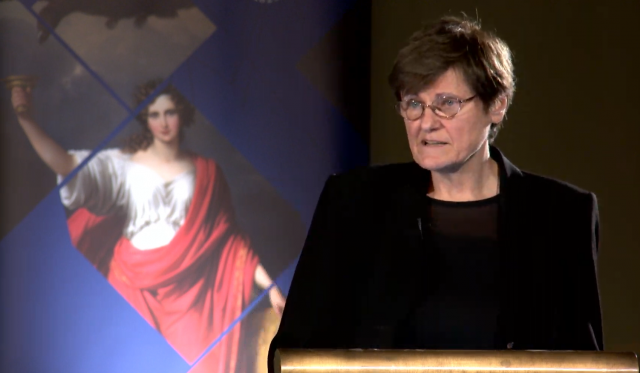Katalin Karikó named a Nobel laureate
The 2023 Nobel Prize in Physiology or Medicine has been awarded to Katalin Karikó and Drew Weissman for their shared biochemical discoveries that enabled the development of an effective mRNA-based vaccine against COVID-19.
Katalin Karikó began her scientific career at the Biological Research Centre of Szeged in the 1980s and quickly became involved in the study of messenger RNA (mRNA), which we may remember from our high school studies as helping our cells make protein from information stored in DNA. It’s like copying a page from the vast library of blueprints in our cells and sending it to the factory (the ribosome) to make what this blueprint Press release from the Nobel Prize Assembly at Karolinska Institutetdescribes.
 Katalin Karikó Source: mta.hu / Tamás Szigeti
Katalin Karikó Source: mta.hu / Tamás SzigetiThe young researcher felt that this mechanism could be exploited to great effect to give instructions to a cell from the outside to make different useful molecules, essentially using our own body as a “pharmaceutical factory”.
Katalin Karikó was born in 1955 in Szolnok. Her specific areas of expertise include biochemistry, molecular biology, messenger RNA research and the therapeutic applications of mRNA in humans. She showed that the immunogenic effect of mRNA is caused by uridine, whose replacement with natural nucleosides, mainly pseudouridine, prevents inflammation and immune responses. Her pioneering work opened a new era in the treatment and prevention of many diseases, including cancer. The modified mRNA technology has been the basis for the development of mRNA vaccines against SARS-CoV-2 by the BioNTech-Pfizer and Moderna consortia, helping to contain the global pandemic and save millions of lives
Her ideas were not generally received with great enthusiasm, partly due to the limitations of the laboratory technology of the time, and so for much of her life as a researcher she could not afford to focus her research purely on the mechanism itself. She needed an experienced researcher to support her in connection with some specific project where there was a chance to apply mRNA technology. Just such a case arose when the University of Pennsylvania Hospital tried to use the method in the treatment of stroke patients. The basic idea was that it might be worth dilating the blood vessels in the area of the brain where blood supply was impaired after a stroke. To do this, the body uses a compound called nitric oxide, but this molecule is converted so quickly in the blood that there is no chance of getting it to the right place by injection.
The idea was to use mRNA to introduce into the cells a “blueprint” of proteins that produce the nitric oxide themselves, thus avoiding this time-related problem.
Unfortunately, the method – at least in its then form – did not work. (For more on the story, see a previous portrait article that was published in The New York Times.)
The idea of introducing such mRNA blueprints into cells is brilliant, but there are two problems with it. Firstly, a large number of viruses want to do exactly the same thing, i.e. to introduce their own blueprint into our cells in the form of RNA molecules. Secondly, if free RNA fragments appear anywhere outside the cells, it is most certainly bad news: to continue with our original metaphor, the library building has now blown up and the wind is carrying the blueprints down the street. In other words, one of our own cells or an invading foreign cell has died, and its insides have flowed out. The “naked” RNA molecules are therefore bad for our body, and they thus trigger the machinery of the immune system. The A Special issue of Biologia Futura magazine in honour of Katalin Karikóconsequence: immune reaction, inflammation and rapid destruction of RNA fragments.
Entry with body paint only!
The secret and the key to the solution is that in our cells, at least outside the nucleus, the various RNA molecules are not quite “naked”, or at least they have some “body paint”. The groundbreaking 2005 paper by Katalin Karikó, Drew Weissman and their fellow researchers was not considered significant enough for publication by Nature –which would soon have cause to regret its decision, as Immunity did publish it, and as a result they received an avalanche of citations that has only grown since.
In their article, Karikó and her colleagues outline one of the essential friend-and-foe recognition systems of our cells. So let’s take a look at it! When the first copy of the mRNA molecule’s DNA code (i.e. the blueprint sheet) is made in the nucleus, it is made up of the building blocks we learned about in high school, the four types of nucleotide. However, by the time it gets to the ribosome, these building blocks have in many cases undergone modifications; for example, uridine, here and there, becomes a pseudouridine with a slightly different structure. It is striking, and this is what led Karikó and her colleagues to their discovery that longer-lived RNA types such as tRNA, which carries the amino acids that make up proteins, or rRNA, which makes up ribosomes, have a particularly high number of such modifications.
 Katalin Karikó giving a talk at the 194th General Assembly of the Hungarian Academy of Sciences in 2021. Source: mta.hu / Tamás Szigeti
Katalin Karikó giving a talk at the 194th General Assembly of the Hungarian Academy of Sciences in 2021. Source: mta.hu / Tamás SzigetiResearchers have discovered that these tiny changes are just the thing to give RNA molecules a kind of “body paint”, so that the specialist receptors, known as toll-like receptors, of the cells (mainly certain immune cells) do not start sending out wild alarm signals when they encounter one. It also appears that there are far more such modifications in mammalian cell RNA molecules than in bacteria, and there are even indications that some RNA viruses mimic these modifications in an attempt to circumvent this friend-and-foe recognition system.
And once we have figured out the “body paint” of our own cells’ RNA molecules,
this knowledge can also be used to smuggle our own message into the cells by “painting” it as a friend. This is how mRNA vaccines were born – it was this idea that was used by the Pfizer-BioNTech and Moderna’s vaccine in the COVID pandemic.
A basic research proposition that was well ahead of the technical readiness of its time came to fruition with the Immunity article published in 2005, and it provided perhaps the most effective weapon against the coronavirus epidemic a decade and a half later. And it is not hard to see that once we have the means to send genetic messages to our cells, all we need is more basic research to explore the cellular machinery in depth to use our body’s biochemical mechanisms in a variety of ways to heal ourselves.
Lipid footnote
Anyone with a little knowledge of the mechanism of coronavirus vaccines will know that in the case of Pfizer-BiNTech and Moderna, the mRNA molecules are delivered to the cells in tiny lipid or fat droplets. The question is, why all this body painting stuff if you can trick the immune system anyway? Well, the sad (or, on second thoughts, happy) truth is that it’s not that simple. Some of the receptors that detect foreign RNA fragments are actually located on the surface of the immune cells, but others activate when something enters the cell’s membrane. In such cases, they encounter an RNA fragment escaping from the lipid droplet, and woe betide them if their body paint does not conform to the dress code.
How the vaccine protects us – MTA’s animation skit on the mechanism of action of coronavirus vaccines



